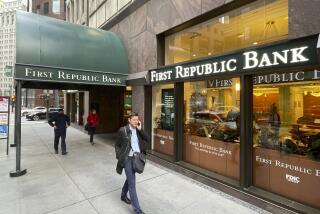Great Western Buys Failed Lincoln’s Deposits, Branches : Thrifts: The Irvine-based S&L; is removed from the rolls of money-losers with a purchase price of $12.1 million.
- Share via
Great Western Bank on Friday acquired the deposits and 28 branches of Lincoln Savings & Loan for $12.1 million. Federal regulators also disclosed that the taxpayer tab for cleaning up Irvine-based Lincoln will be $2.6 billion, making it the costliest S&L; collapse ever.
The sale means that the once high-flying Lincoln--whose demise is linked to speculative real estate and junk bond investments--will be removed from the rolls of the nation’s money-losing thrifts.
Lincoln and its former owner, Phoenix businessman Charles H. Keating Jr., are symbols of all that went wrong in the thrift industry. But while it may pass from view, Lincoln’s ignominious legacy lives on in U.S. Senate corridors, federal and state courtrooms and in the memories of thousands of Southern California investors who lost savings there.
That could be seen in a separate development Friday. Federal prosecutors in Los Angeles filed a criminal complaint against Ray C. Fidel, a former Lincoln president, for securities fraud stemming from the marketing of junk bonds at Lincoln branches.
It is the second round of charges stemming from a federal grand jury investigation of Lincoln’s failure. The probe is targeting Keating, former chairman of American Continental Corp., Lincoln’s Phoenix-based parent.
The Resolution Trust Corp., the federal agency overseeing the bailout of insolvent thrifts, put Lincoln up for sale in November. Beverly Hills-based Great Western said it acquired more than $2 billion in Lincoln deposits and what it termed “a jewel of a branch system.”
The Lincoln branches will be reopened Monday for business as usual as Great Western offices.
All deposits acquired by Great Western will continue to be covered by federal insurance up to $100,000. However, the thrift said it will change interest rates on some Lincoln accounts in the near future.
Great Western also acquired about $6 million in cash on hand and securities but otherwise stayed away from Lincoln’s troubled assets, which include vast real estate holdings in the Arizona desert and some junk bonds. Regulators have said that Lincoln’s assets were overvalued, and they have written them down over the past two years.
“Great Western prefers to create its own assets using its stringent underwriting criteria,” the thrift said in a statement. “Our purchase of Lincoln essentially involved only the deposits or liabilities and the branches of Lincoln.”
Some Lincoln branch signs will be changed over the weekend, but it will take several months for its computer and other operations to be fully assimilated into the banking business of Great Western, now the nation’s second-largest thrift.
All 200 of Lincoln’s branch employees will be offered jobs with Great Western, but it was unclear late Friday whether 50 administrative employees would continue with the Beverly Hills thrift.
The $12.1 million that Great Western paid for the deposits is considered cheap by industry consultants, a fact acknowledged by the thrift’s chairman and chief executive, James F. Montgomery.
“The acquisition of Lincoln Savings on these favorable terms is an outstanding opportunity to expand and complement Great Western’s California branch system,” Montgomery said. “It will enable Great Western . . . to enlarge its customer base.”
The payment represents just 1.2% of Lincoln’s $1 billion in so-called “core deposits”--stable money that is less likely to be shifted by depositors to other institutions. Such deposits are valuable also because they provide a cheap source of funds.
Institutions typically pay lower amounts of interest on those accounts than they do for other sources of money. By buying the deposits of Lincoln and other failed thrifts, Great Western can replace its higher-cost deposits, such as borrowings from the Federal Home Loan Bank system and large deposits from institutions that demand high rates.
The premium drew criticism from Keating’s son-in-law and spokesman, Bradley J. Boland, who called the low purchase price “disgusting.” He said regulators wasted a chance to avoid a huge loss by refusing to approve a $500-million sale of Lincoln just before it was seized in April, 1989. Regulators said then there wasn’t enough cash in the deal.
The $2.6-billion tab on Lincoln’s failure exceeds the $2.58 billion cost of the collapse of University Federal Savings in Houston, which had been the costliest thrift demise.
Great Western’s purchase will give the institution nearly $30 billion in deposits and 241 retail banking branches in California.
GREAT WESTERN AT A GLANCE Headquarters: Beverly Hills Principal subsidiary: Great Western Bank Total assets: $39.4 billion as of Dec. 31, second largest in nation Total deposits: $29.4 billion Earnings: $193 million in 1990. States: California, Florida, Arizona and Washington Number of Branches: 405 (including Lincoln’s), with 241 in California Risk-adjusted capital ratio: 8.9% (federal minimum 8.0%)
More to Read
Inside the business of entertainment
The Wide Shot brings you news, analysis and insights on everything from streaming wars to production — and what it all means for the future.
You may occasionally receive promotional content from the Los Angeles Times.










